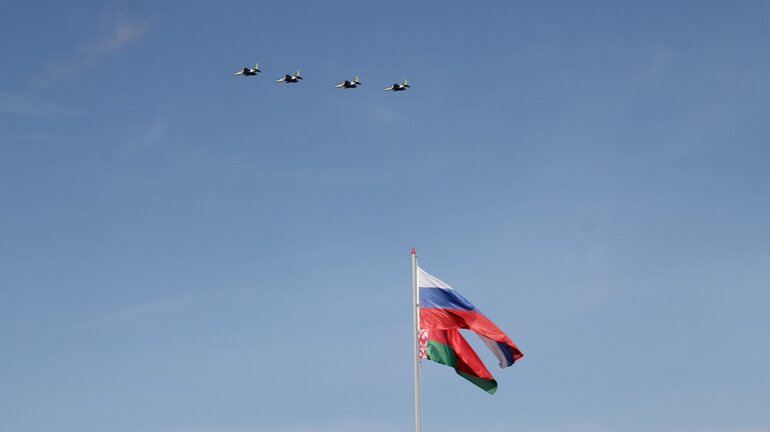Postscript to Zapad-2017

There has been much commentary and speculation about the joint Russian-Belarusian military exercise that took place 14–20 September. Western military officials and analysts have evoked various threat scenarios, which reflects worsening Russia-NATO relations. Now, most facts are on the table, and they are less alarming than initially expected. This year’s manoeuvres did not differ much from previous Zapad exercises in 2009 or 2013. Zapad-2017 was a largely defensive exercise that rehearsed the defence of Belarus against a hypothetical NATO intervention by conventional forces—not a hybrid attack as previously supposed. Nevertheless, the attention on numbers, dislocation plans, and possible hidden agendas was unprecedented.
The fact that Russia’s Kaliningrad exclave became part of the exercise fostered the suspicion that Russia might breach the so-called Suwalki gap, a territorial corridor on the border between Lithuania and Poland that separates Kaliningrad from Belarus. Western reports that Zapad-2017 could become a prelude to an offensive operation against neighbouring NATO states provoked predictable denials from Russian deputy defence minister Aleksandr Fomin. Furthermore, expectations that around 100,000 soldiers would participate in the exercise did not take into consideration that accompanying forces from the National Guard, the Federal Security Service, and various Russian power ministries as well as combat support units were not part of active forces.
Almost certainly, however, the real number of participating troops did exceed the announced figure of 12,700 (including Belarusian land forces). The ceiling stipulated by the OSCE above which an exercise becomes subject to observation is 13,000. Moreover, it was evident that Zapad-2017 served as a testing ground for advances in Russian military capabilities and as an experiment to probe lessons from Russia’s military interventions in Ukraine and Syria.
Official reactions in Belarus
The perceptions and reactions to the manoeuvres from Belarus, one of the two participating states and a major site of the exercise, received less attention. Belarus found itself in a difficult situation: On the one hand, it had just improved its relations with the West, boosted itself as a mediator during the Minsk process, and tentatively tried to emancipate itself from Russian dependency. Many observers noted that if Belarusian president Aleksandr Lukashenko had had a choice, he would have renounced a large-scale military exercise with Russia, which is now widely regarded as an aggressor state. On the other hand, Belarus felt the need to demonstrate to Moscow the validity of the Belarusian-Russian alliance, despite the fact that Russia is seen in Minsk as an unpredictable partner.
To reassure international and domestic audiences, the Belarusian Ministry of Defence invested in transparency. It launched a website on Zapad-2017 offering daily information, photos, and videos documenting the exercise. It invited national and international journalists as well as over 90 observers from international organisations and defence attachés who were accredited in embassies in Minsk to visit the active phase of the drills.
All this notwithstanding, inside the country, a heated information exchange unfurled around Zapad-2017, with local observers and media sharply criticising the PR campaign of the Defence Ministry. On 29 August, the chief of the armed forces, General Oleg Belokonev, organised a briefing for a select group of media representatives, but with no possibility of follow-up questions.
Critical voices
On 11 September, a few days before the official launch of Zapad-2017, the Belarusian opposition, led by the United Civic Party, organised a conference on the topic, inviting national and international experts as well as parliamentarians from Lithuania, Poland, and Ukraine. State representatives were also invited but did not respond to the invitation.
The fact that the Belarusian Foreign Ministry denied the Lithuanian delegation diplomatic entry visas resulted in yet another small political scandal. The conference took place all the same, with the Lithuanian participants joining the discussion via Skype. The visa denial was probably due not only to the sensitivity of the topic but also to the fact that Lithuanian parliamentarian Laurynas Kasčiūnas had fallen from grace with the Belarusian leadership ever since he tabled a Belarusian-critical resolution during the July annual session of the OSCE Parliamentary Assembly in Minsk.
During the conference, views were expressed that Russia could potentially leave troops behind to pressure or destabilise the country. Former Lithuanian foreign minister Audronius Ažubalis criticised Lukashenko’s proposal for a new Helsinki process. This would preserve the status quo of the occupation of Georgian and Ukrainian territories by Russia, which Ažubalis held personally accountable for ruining the Helsinki Final Act. The leader of the left-wing party Just World, Sergey Kalyakin, saw no reason to worry. ‘The agitation around Zapad-2017 was linked to domestic political questions in those countries,’ he said. As for Belarus, the major issue, according to Kalyakin, ‘was the absence of any form of democratic control of state activities’.
Between humour and concern
Conference participants agreed to the demand for an adaptation of the Budapest Memorandum, to provide it with a legally binding character so that signatory states would eventually be obliged to comply with their commitments. Concerns over the preservation of the national sovereignty and independence of Belarus were also shared in the country’s regions. A Belarusian team of reporters travelled to some of the sites where Russian soldiers were dislocated, to sense the mood among the local population. The majority of interviewees were not at ease with the presence of Russian soldiers on Belarusian territory.
The country’s online community, on the contrary, treated the story of Zapad-2017 with humour. The scenario invented by military strategists consisted of a joint attack on Belarus by a coalition of three fictitious states: Veishnoriya, Lubeniya, and Vesbariya, with the former located in north-western Belarus. Soon after this fact became publicly known, a parody of Veishnoriya became a full-fledged state with its own flag, coat of arms, Twitter account, and national anthem.
Nadja Douglas is a research associate at ZOiS.